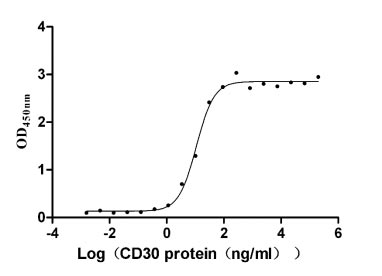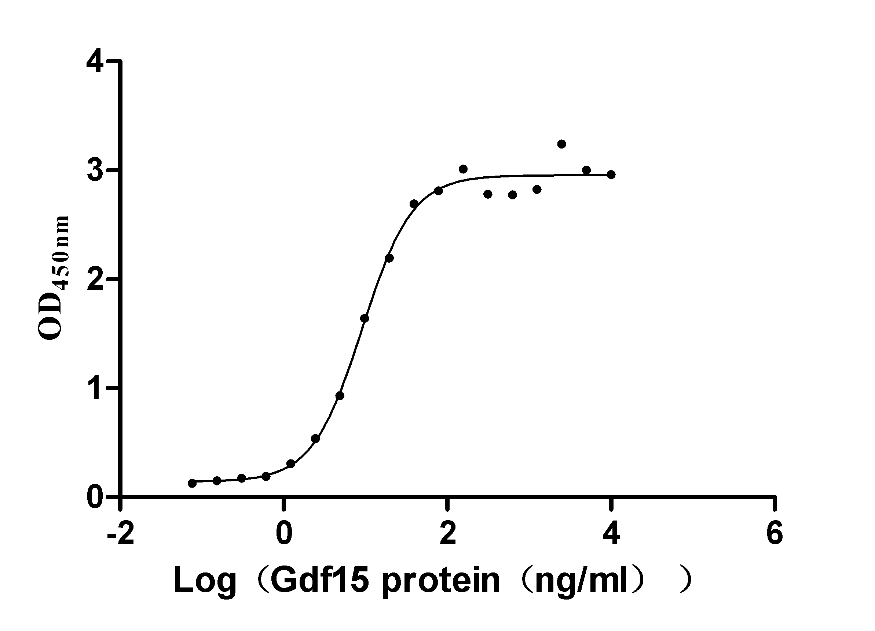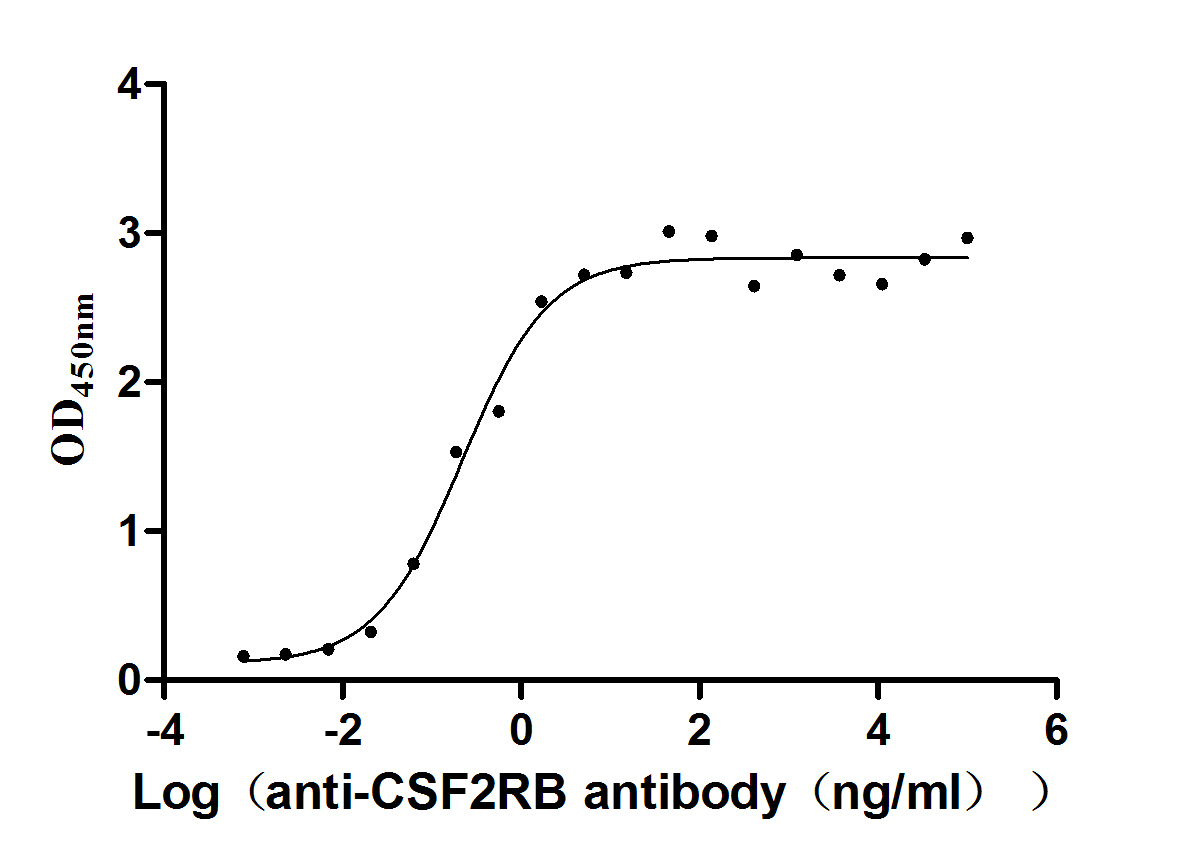Recombinant Mouse DNA- (apurinic or apyrimidinic site) lyase (Apex1)
-
货号:CSB-YP001900MO
-
规格:
-
来源:Yeast
-
其他:
-
货号:CSB-EP001900MO
-
规格:
-
来源:E.coli
-
其他:
-
货号:CSB-EP001900MO-B
-
规格:
-
来源:E.coli
-
共轭:Avi-tag Biotinylated
E. coli biotin ligase (BirA) is highly specific in covalently attaching biotin to the 15 amino acid AviTag peptide. This recombinant protein was biotinylated in vivo by AviTag-BirA technology, which method is BriA catalyzes amide linkage between the biotin and the specific lysine of the AviTag.
-
其他:
-
货号:CSB-BP001900MO
-
规格:
-
来源:Baculovirus
-
其他:
-
货号:CSB-MP001900MO
-
规格:
-
来源:Mammalian cell
-
其他:
产品详情
-
纯度:>85% (SDS-PAGE)
-
基因名:
-
Uniprot No.:
-
别名:Apex1; Ape; Apex; Ref1DNA-(apurinic or apyrimidinic site) lyase; EC 3.1.-.-; EC 4.2.99.18; APEX nuclease; APEN; Apurinic-apyrimidinic endonuclease 1; AP endonuclease 1; REF-1; Redox factor-1) [Cleaved into: DNA-(apurinic or apyrimidinic site) lyase; mitochondrial]
-
种属:Mus musculus (Mouse)
-
蛋白长度:Full Length of Mature Protein
-
表达区域:2-317
-
氨基酸序列PKRGKKAAA DDGEEPKSEP ETKKSKGAAK KTEKEAAGEG PVLYEDPPDQ KTSPSGKSAT LKICSWNVDG LRAWIKKKGL DWVKEEAPDI LCLQETKCSE NKLPAELQEL PGLTHQYWSA PSDKEGYSGV GLLSRQCPLK VSYGIGEEEH DQEGRVIVAE FESFVLVTAY VPNAGRGLVR LEYRQRWDEA FRKFLKDLAS RKPLVLCGDL NVAHEEIDLR NPKGNKKNAG FTPQERQGFG ELLQAVPLAD SFRHLYPNTA YAYTFWTYMM NARSKNVGWR LDYFLLSHSL LPALCDSKIR SKALGSDHCP ITLYLAL
-
蛋白标签:Tag type will be determined during the manufacturing process.
The tag type will be determined during production process. If you have specified tag type, please tell us and we will develop the specified tag preferentially. -
产品提供形式:Lyophilized powder
Note: We will preferentially ship the format that we have in stock, however, if you have any special requirement for the format, please remark your requirement when placing the order, we will prepare according to your demand. -
复溶:We recommend that this vial be briefly centrifuged prior to opening to bring the contents to the bottom. Please reconstitute protein in deionized sterile water to a concentration of 0.1-1.0 mg/mL.We recommend to add 5-50% of glycerol (final concentration) and aliquot for long-term storage at -20℃/-80℃. Our default final concentration of glycerol is 50%. Customers could use it as reference.
-
储存条件:Store at -20°C/-80°C upon receipt, aliquoting is necessary for mutiple use. Avoid repeated freeze-thaw cycles.
-
保质期:The shelf life is related to many factors, storage state, buffer ingredients, storage temperature and the stability of the protein itself.
Generally, the shelf life of liquid form is 6 months at -20°C/-80°C. The shelf life of lyophilized form is 12 months at -20°C/-80°C. -
货期:Delivery time may differ from different purchasing way or location, please kindly consult your local distributors for specific delivery time.Note: All of our proteins are default shipped with normal blue ice packs, if you request to ship with dry ice, please communicate with us in advance and extra fees will be charged.
-
注意事项:Repeated freezing and thawing is not recommended. Store working aliquots at 4°C for up to one week.
-
Datasheet :Please contact us to get it.
靶点详情
-
功能:Multifunctional protein that plays a central role in the cellular response to oxidative stress. The two major activities of APEX1 are DNA repair and redox regulation of transcriptional factors. Functions as a apurinic/apyrimidinic (AP) endodeoxyribonuclease in the DNA base excision repair (BER) pathway of DNA lesions induced by oxidative and alkylating agents. Initiates repair of AP sites in DNA by catalyzing hydrolytic incision of the phosphodiester backbone immediately adjacent to the damage, generating a single-strand break with 5'-deoxyribose phosphate and 3'-hydroxyl ends. Does also incise at AP sites in the DNA strand of DNA/RNA hybrids, single-stranded DNA regions of R-loop structures, and single-stranded RNA molecules. Has a 3'-5' exoribonuclease activity on mismatched deoxyribonucleotides at the 3' termini of nicked or gapped DNA molecules during short-patch BER. Possesses a DNA 3' phosphodiesterase activity capable of removing lesions (such as phosphoglycolate) blocking the 3' side of DNA strand breaks. May also play a role in the epigenetic regulation of gene expression by participating in DNA demethylation. Acts as a loading factor for POLB onto non-incised AP sites in DNA and stimulates the 5'-terminal deoxyribose 5'-phosphate (dRp) excision activity of POLB. Plays a role in the protection from granzymes-mediated cellular repair leading to cell death. Also involved in the DNA cleavage step of class switch recombination (CSR). On the other hand, APEX1 also exerts reversible nuclear redox activity to regulate DNA binding affinity and transcriptional activity of transcriptional factors by controlling the redox status of their DNA-binding domain, such as the FOS/JUN AP-1 complex after exposure to IR. Involved in calcium-dependent down-regulation of parathyroid hormone (PTH) expression by binding to negative calcium response elements (nCaREs). Together with HNRNPL or the dimer XRCC5/XRCC6, associates with nCaRE, acting as an activator of transcriptional repression. Stimulates the YBX1-mediated MDR1 promoter activity, when acetylated at Lys-6 and Lys-7, leading to drug resistance. Acts also as an endoribonuclease involved in the control of single-stranded RNA metabolism. Plays a role in regulating MYC mRNA turnover by preferentially cleaving in between UA and CA dinucleotides of the MYC coding region determinant (CRD). In association with NMD1, plays a role in the rRNA quality control process during cell cycle progression. Associates, together with YBX1, on the MDR1 promoter. Together with NPM1, associates with rRNA. Binds DNA and RNA.
-
基因功能参考文献:
- We suggest that serum APE1/Ref-1 can be used to assess for myocardial injury in viral myocarditis without endomyocardial biopsy PMID: 29292734
- AOM, a colorectal cancer carcinogen, generates damage to the mitochondrial genome, and the BER enzyme APE1 is required to maintain its integrity. PMID: 28360037
- findings provide evidence that endogenous APE1 protects against ischemic infarction in both gray and white matter and facilitates the functional recovery of the central nervous system after mild stroke injury PMID: 27274063
- Suppression of Ape1/Ref-1 redox function leads to an increased cell surface retention of IL-12 and enhances Th1 responses. PMID: 27637330
- Is closely associated with upregulation of the Ref1/Nrf2 signalling pathway. PMID: 26682532
- Results show the stimulatory effect of PARP-1 on APE1-dependent base excision repair (BER). PARP-1 and APE1 appear to have a functional interaction in BER since PARP-1 can stimulate the strand incision activity of APE1. PMID: 26020771
- increases in APEX1 level confer protection against the murine paternal age effect, thus highlighting the role of APEX1 in preserving reproductive health with increasing age and in protection against genotoxin-induced mutagenesis in somatic cells PMID: 26201249
- Endothelial cell tumor proliferation was found to be dependent on Apex-1 expression. PMID: 26108661
- Expression of OGG1 and APEX1 was decreased at 3h after last exposure to Aroclor 1254 and only the expression level of APEX1 was recovered at 24-h after, so inhibition of DNA repair can be a potential mode of action of Aroclor 1254 gonadal toxicity. PMID: 25113976
- Data indicate that the endonuclease activity of APE1 is required for class switch recombination (CSR). PMID: 25404348
- These results suggest that mitochondrial APE1/Ref-1 is contributed to the protective role to protein kinase C-induced mitochondrial dysfunction in endothelial cells. PMID: 24861944
- Spinal motor neurones down-regulate APE1 upon oxidative stress. This property renders motor neurones susceptible to continuous challenge of oxidative stress in pathological conditions. PMID: 23808792
- The reductive activation of endothelial SIRT1 by APE1/Ref-1 mediates the effect of APE1/Ref-1 on eNOS acetylation, promoting endothelium-derived NO and endothelium-dependent vasorelaxation. PMID: 23755229
- Together, these data show that the expression of APE1 is crucial for efficient transcription of ribosomal genes. PMID: 24648491
- Ape1, an enzyme required for processing apurinic/apyrimidinic (known as abasic) sites, is also involved in the generation of small DNA fragments during DNA repair. PMID: 25210033
- Voluntary running wheel exercise significantly increases levels of BDNF, activates CREB, and upregulates APE1 in the cerebral cortex and hippocampus of mice. PMID: 24114393
- data provide new insight into error-prone repair of AID-induced lesions, which we propose is facilitated by down-regulation of APE1 and up-regulation of APE2 expression in germinal center B cells. PMID: 24927551
- Transient OGG1, APE1, PARP1 and Polbeta expression in an Alzheimer's disease mouse model. PMID: 24121118
- APE1 enhances in vivo vascular repair effects of endothelial progenitor cells in part through the maintenance of adhesion properties of EPCs during oxidative stress. PMID: 23934858
- Data indicate an association of ovarian stimulation with a downregulation of mRNAs encoding the base excision repair proteins APEX1 and POLB as well as the 5-methyl-CpG-binding domain protein MBD3 in individual morula embryos. PMID: 23154201
- Energy failure-induced Ape1 depletion triggers neuronal death in ischemic brain injuries. PMID: 22841870
- the mouse-renin gene is regulated by apurinic/apyrimidinic-endonuclease 1 (APE1/Ref-1) via recruitment of histone deacetylase 1 corepressor complex PMID: 22441348
- these findings are the first demonstration that Ape1/Ref-1 is an indispensable molecule for the IL-21-mediated signal transduction through ERK1/2 activation. PMID: 22450323
- Mutant frequency and nuclear DNA damage increased earlier in spermatogenic cells from Apex1(+/-) mice (by 6 months of age). By old age, mutant frequencies were similar for wild-type and APEN-deficient mice. PMID: 21919107
- APE1 suppresses oxLDL-induced p66shc activation in endothelial cells by inhibiting PKCbetaII-mediated serine phosphorylation of p66shc, and mitigates vasoconstriction induced by activation of PKC. PMID: 21467074
- Data show that Mad2 haploinsufficiency is protective in the presence of a cycle-specific DNA synthesis agent in vivo, and Ape1/Ref-1 inhibitor in vitro. PMID: 21216274
- These findings suggest that cell death is initiated by reducing APE/Ref-1 protein and inhibiting its repair function. PMID: 20637286
- Cytoplasmic Ape1 could enhance lung tumor malignancy through NF-kappaB activation. PMID: 20498636
- The stoichiometry of base excision repair enzymes is one critical factor underlying the tissue selectivity of somatic CAG expansion. PMID: 19997493
- study indicates that IL-6 induces a novel STAT3-APE1 complex, whose interaction is required for stable chromatin association in the IL-6-induced hepatic acute phase response PMID: 20032196
- Data show that the rabbit anti-human APE1 polyclonal antibody with high titer and specificity can be used not only to elucidate the roles of APE1 protein in cellular procedures, but also to detect the expression of the APE1 protein in mice and rats. PMID: 19351502
- indicates that Apex1 can generate complex double strand breaks from clustered lesions consisting of base damage and abasic sites. PMID: 19800300
- promoter regions and tissue distribution of APEX PMID: 12200116
- Il-2 induction of ref-1 protein may be involved in the regulation of telomerase activity. PMID: 12647295
- Ref-1 has a role in redox regulation of AP-1 DNA binding PMID: 12773568
- Brain expression of apurinic/apyrimidinic endonuclease (APE/Ref-1) multifunctional DNA repair enzyme gene in the mouse with special reference to the suprachiasmatic nucleus. PMID: 12871766
- changes in base excision repair activity correlated tightly with changes in DNA polymerase beta and Apurinic/apyrimidinic site DNA binding levels PMID: 14973123
- diminution of AP endonuclease has a significant effect on spontaneous mutagenesis in somatic and germ line cells PMID: 15340075
- A novel physiological role for APE1/ref-1 in regulating vascular tone by governance of eNOS activity and bioavailable NO. PMID: 15472121
- Results indicate that the DNA repair and gene regulation functions of APE1 are essential and provide evidence that mammalian cells require APE for survival, presumably to protect against spontaneous oxidative DNA damage. PMID: 15824325
- In sum, loss of a single allele of Ref-1 is sufficient to reduce intimal lesion formation and to alter circulating cytokine and growth factor expression. PMID: 16936011
- Ape1 is critical in normal embryonic hematopoietic development PMID: 17053053
- The ATF4-mediated up-regulation of Ape1 and other genes plays a key role against arsenite-mediated toxicity and mutagenesis. PMID: 17938202
- Both APE1 and APE2 function in antibody switch recomibination, resulting in double stranded breaks necesary for this recombination. PMID: 18025127
- In hepatocytes, ablation of p66(shc) is cytoprotective against hypoxia/reoxygenation-induced oxidative stress, with MnSOD, Ref-1, and Bcl-xL up-regulated, and FLICE down-regulated. PMID: 18191273
- Apex1 makes fine-tuning of CD40-induced B cell proliferation. PMID: 18617267
- Inhibition of the redox function of APE1 blocks murine endothelial cell growth and angiogenesis, and blocks the growth of human tumor cell lines. These effects are independent of the APE1 DNA-repair function. PMID: 18627350
- By 1 month of age, genomic instability increases in livers of Mat1a knockout mice, possibly due to reduced APEX1 levels PMID: 18983843
- increased APE/Ref-1 enhanced DNA repair and inhibited the induction of ischemic oxidative DNA damage and cerebral infarction after ischemia/reperfusion PMID: 19374886
显示更多
收起更多
-
亚细胞定位:Nucleus. Nucleus, nucleolus. Nucleus speckle. Endoplasmic reticulum. Cytoplasm.; [DNA-(apurinic or apyrimidinic site) endonuclease, mitochondrial]: Mitochondrion.
-
蛋白家族:DNA repair enzymes AP/ExoA family
-
组织特异性:Expressed in both resting and stimulated B cells stimulated to switch (at protein level).
-
数据库链接:
KEGG: mmu:11792
STRING: 10090.ENSMUSP00000042602
UniGene: Mm.203
Most popular with customers
-
Recombinant Human 5'-nucleotidase (NT5E) (Active)
Express system: Mammalian cell
Species: Homo sapiens (Human)
-
Recombinant Human Tumor necrosis factor ligand superfamily member 8 (TNFSF8), partial (Active)
Express system: Mammalian cell
Species: Homo sapiens (Human)
-
Recombinant Mouse GDNF family receptor alpha-like (Gfral), partial (Active)
Express system: Mammalian cell
Species: Mus musculus (Mouse)
-
Recombinant Human Cytokine receptor common subunit beta (CSF2RB), partial (Active)
Express system: Mammalian cell
Species: Homo sapiens (Human)
-
Recombinant Human HLA class II histocompatibility antigen gamma chain (CD74), partial (Active)
Express system: Mammalian cell
Species: Homo sapiens (Human)
-
Recombinant Mouse Prolactin receptor (Prlr), partial (Active)
Express system: Mammalian cell
Species: Mus musculus (Mouse)
-
Recombinant Human Claudin-6 (CLDN6)-VLPs (Active)
Express system: Mammalian cell
Species: Homo sapiens (Human)
-
Recombinant Macaca fascicularis Trophoblast glycoprotein (TPBG), partial (Active)
Express system: Mammalian cell
Species: Macaca fascicularis (Crab-eating macaque) (Cynomolgus monkey)






-AC1.jpg)

-AC1.jpg)











